Answered step by step
Verified Expert Solution
Question
1 Approved Answer
Question 1 Instruction: Attached are five (5) articles/cases. In completion of this course work assignment, you are required to perform the following on each: 1.
Question 1
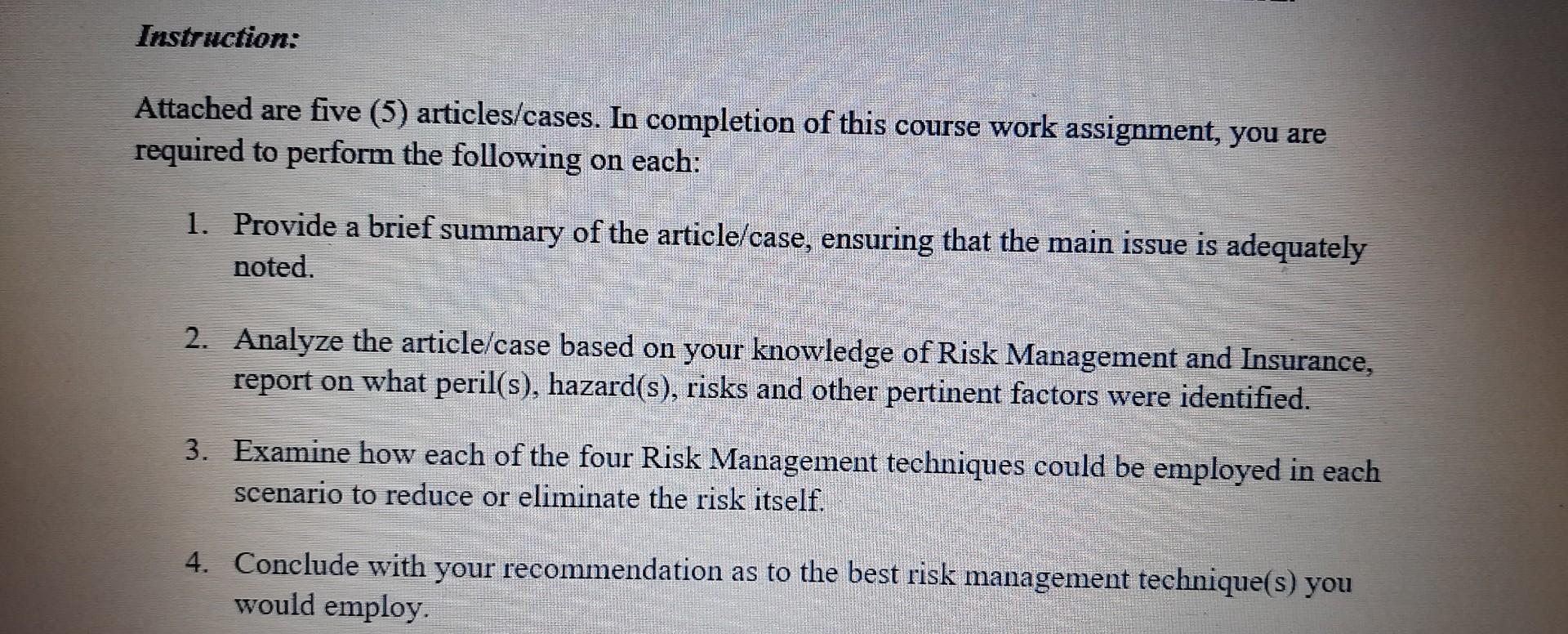
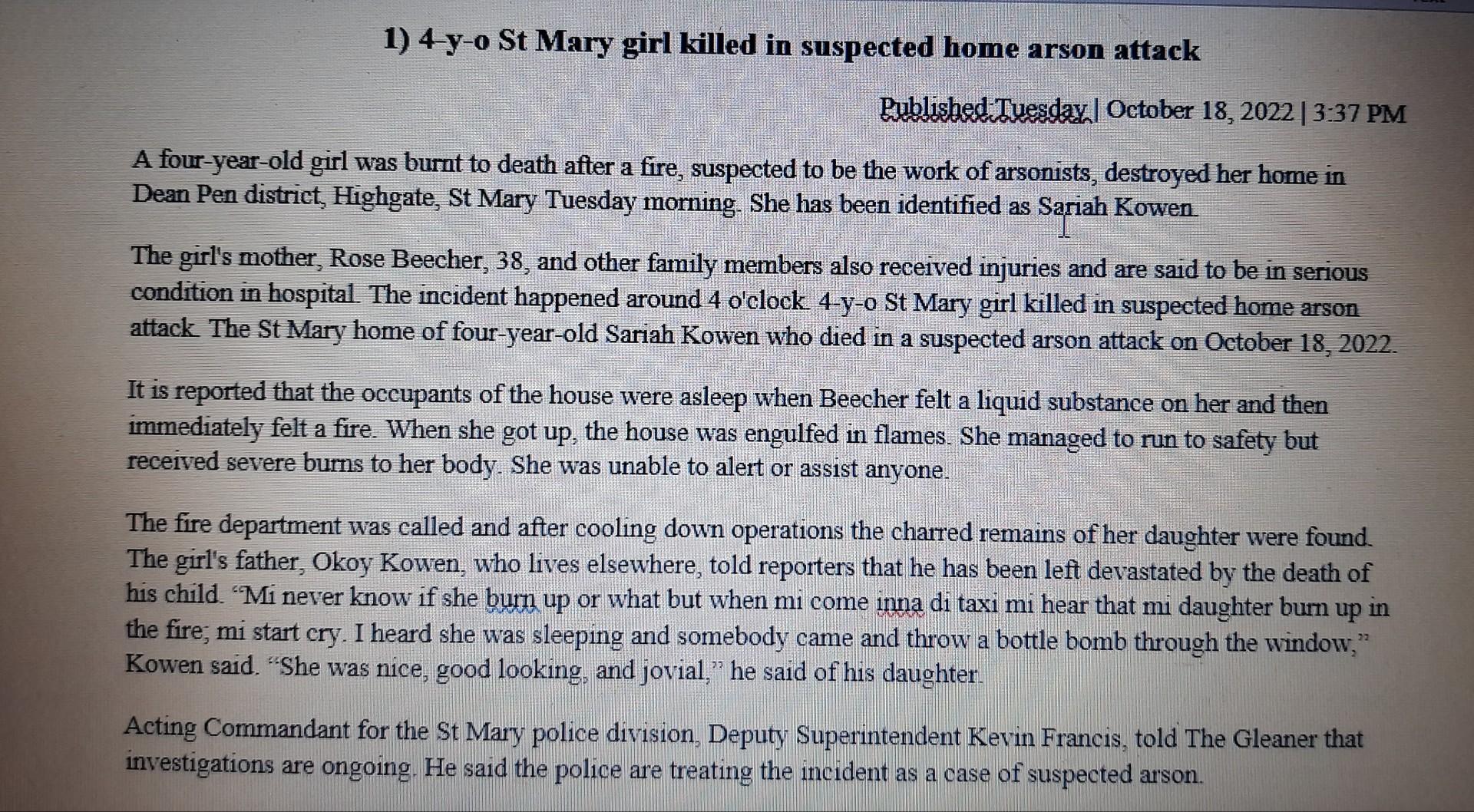
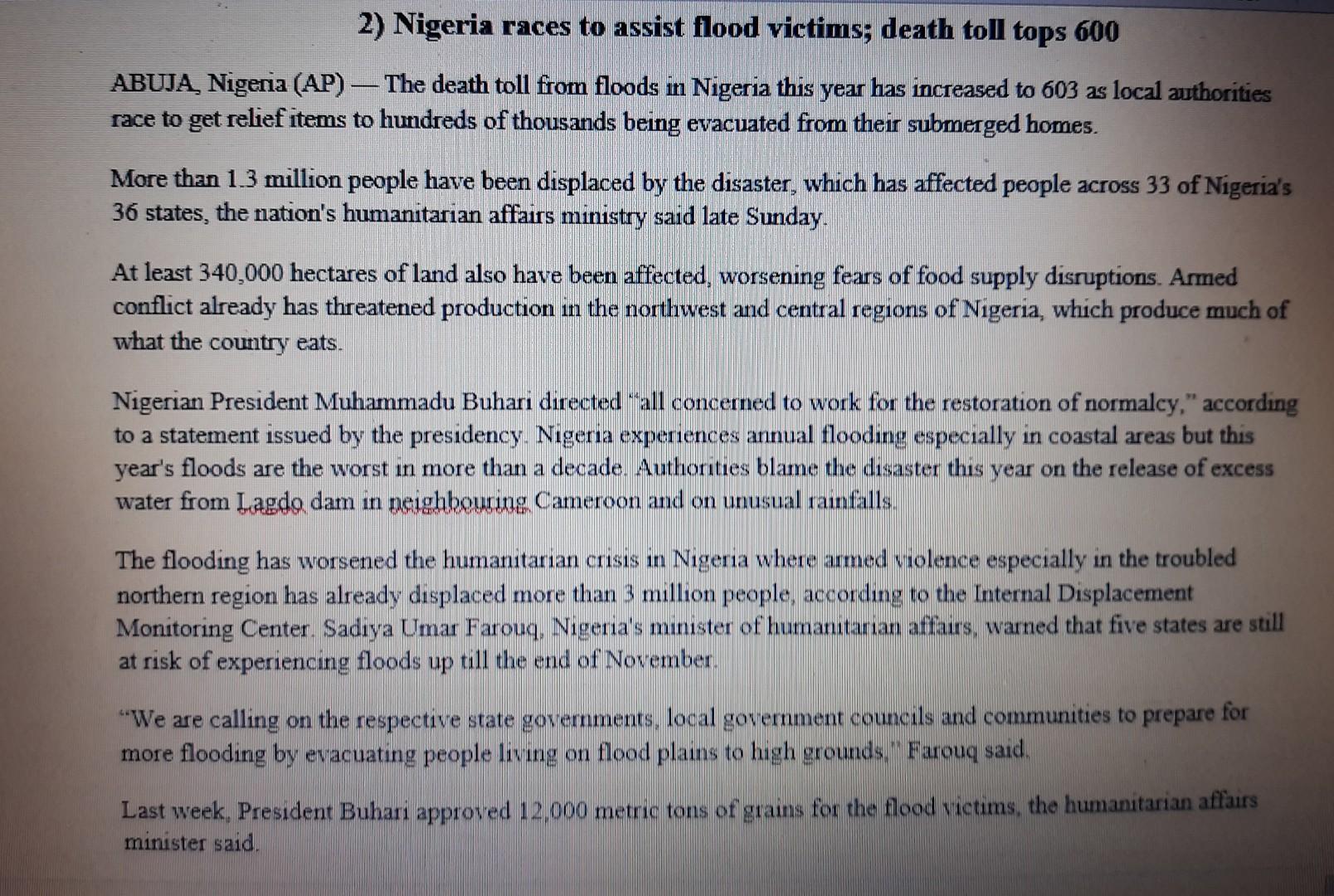
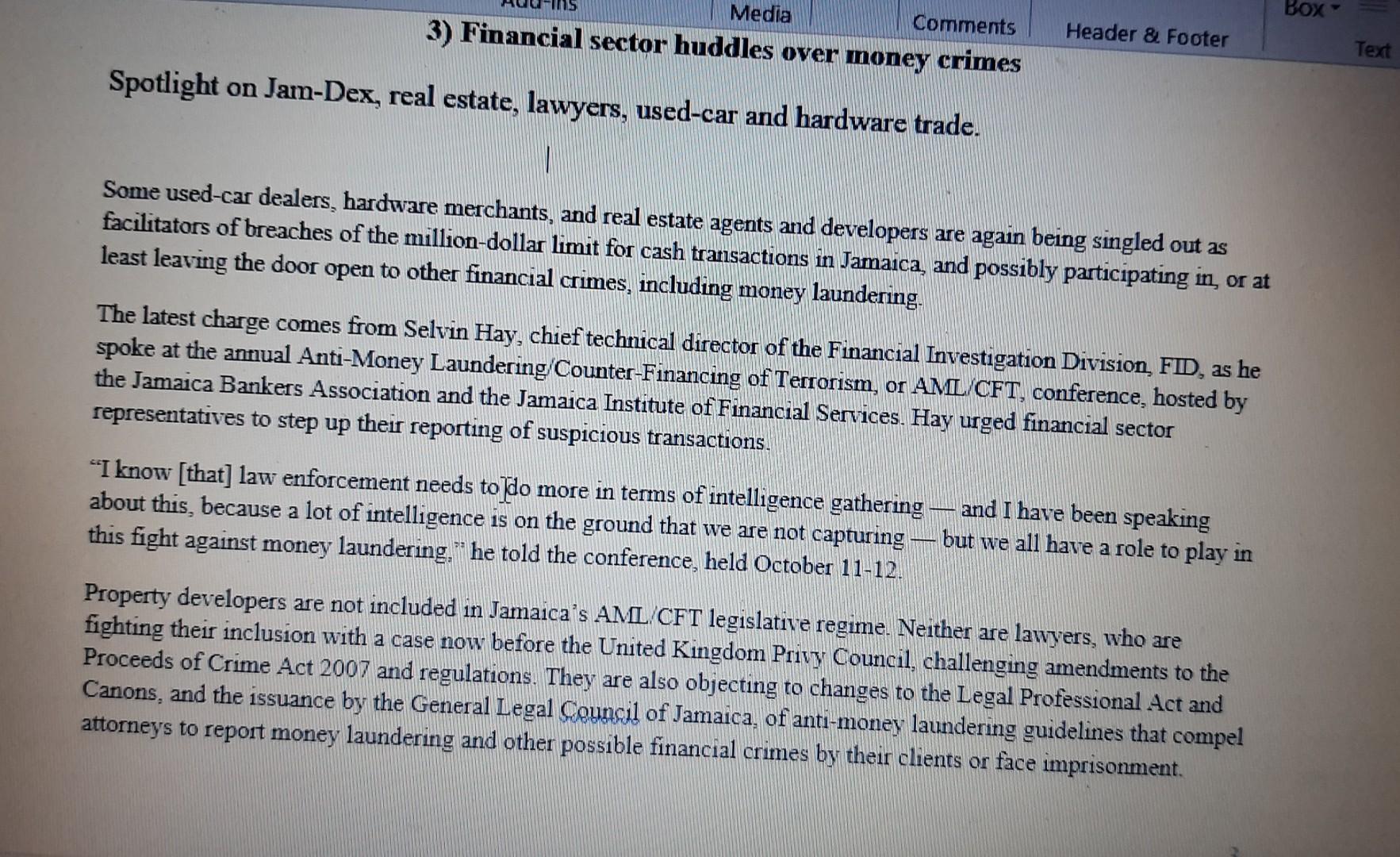
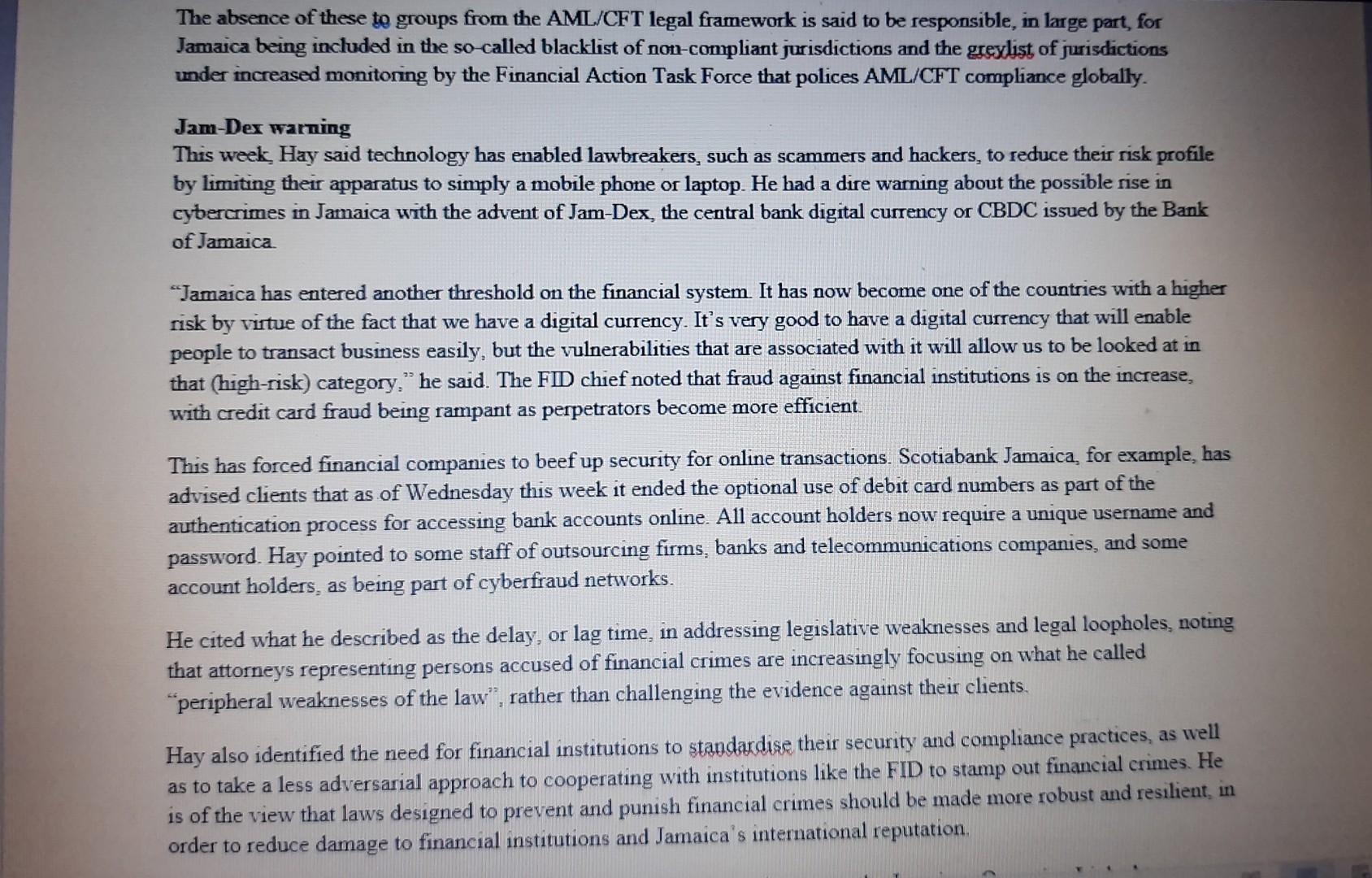


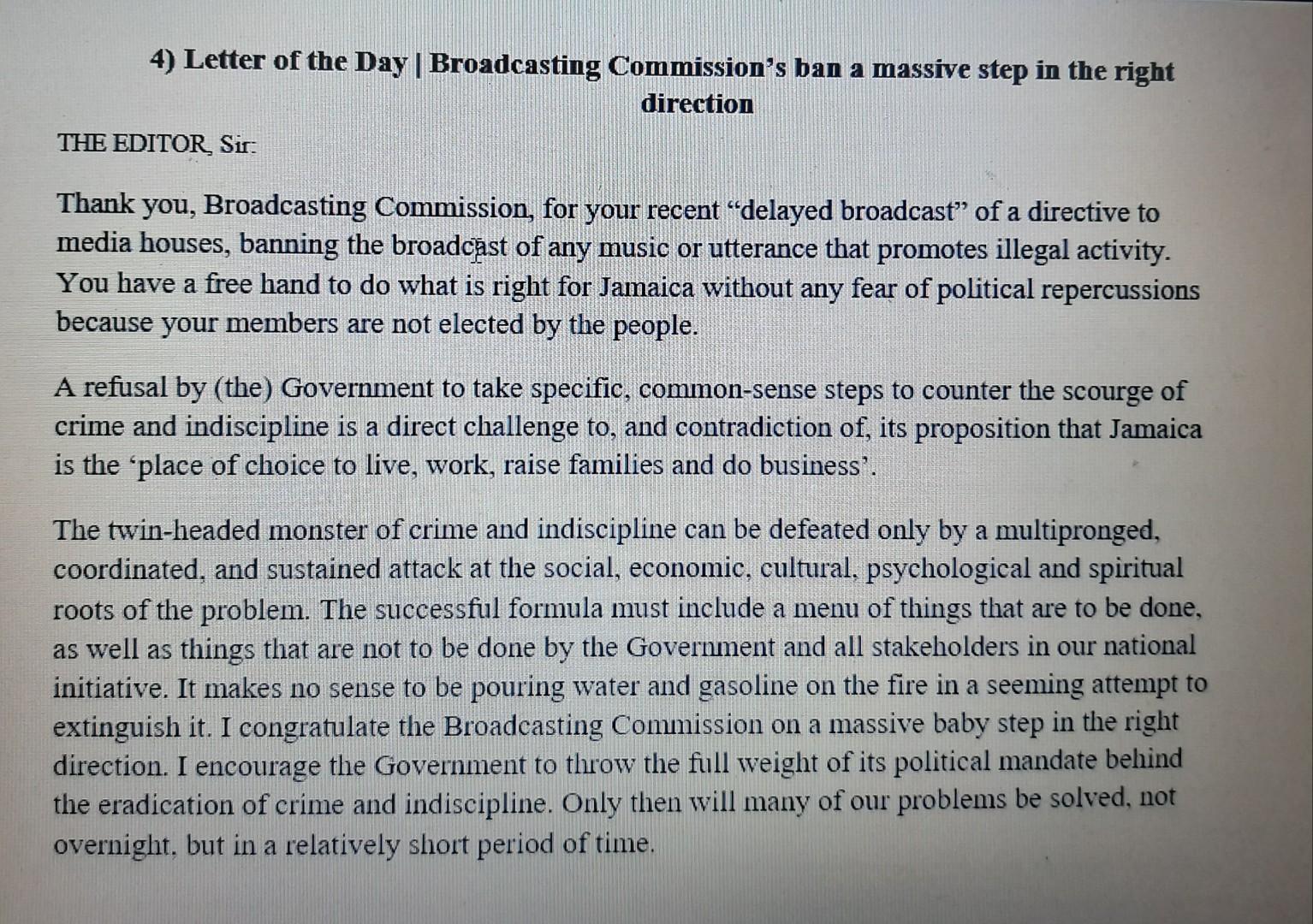
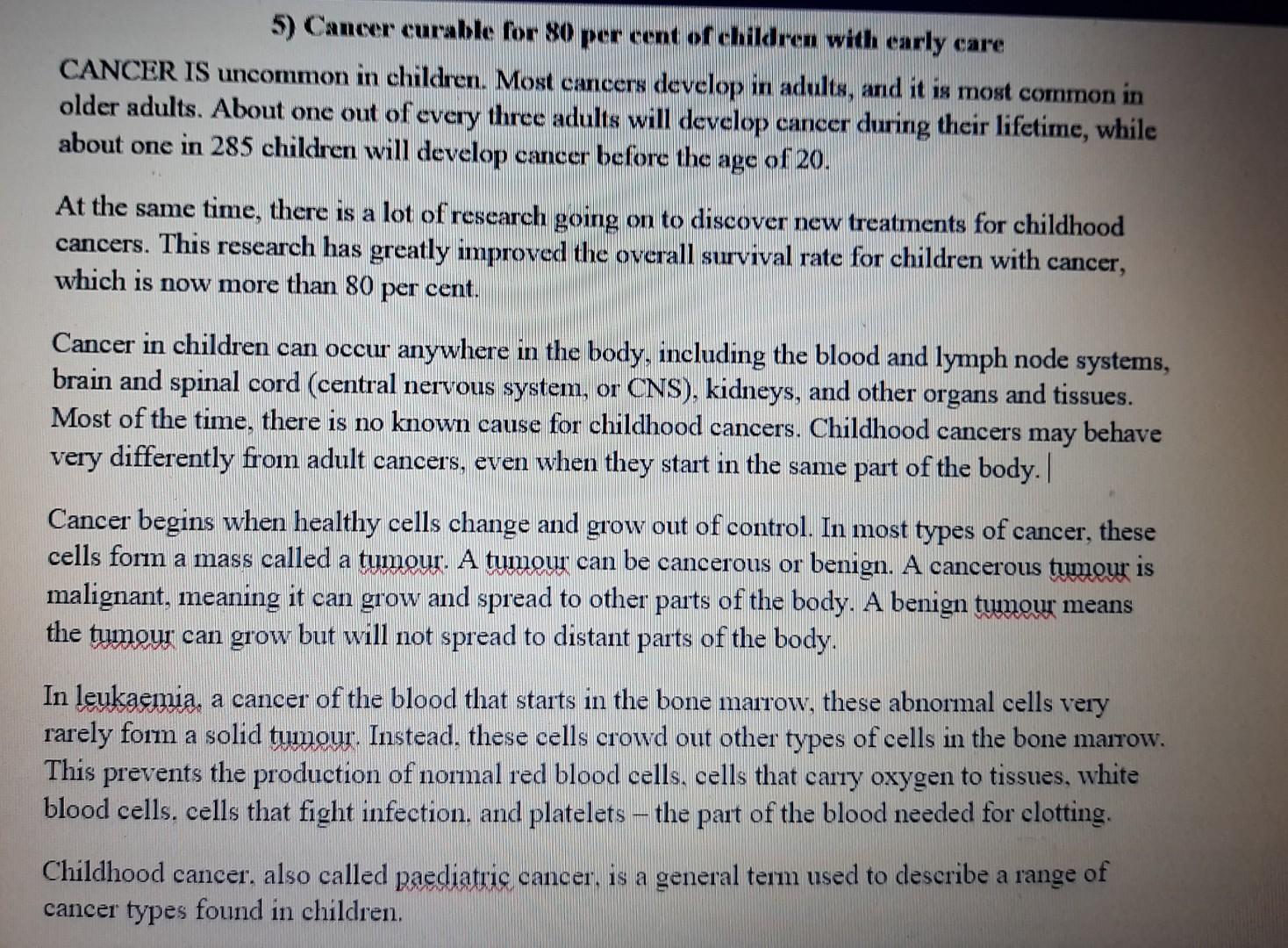
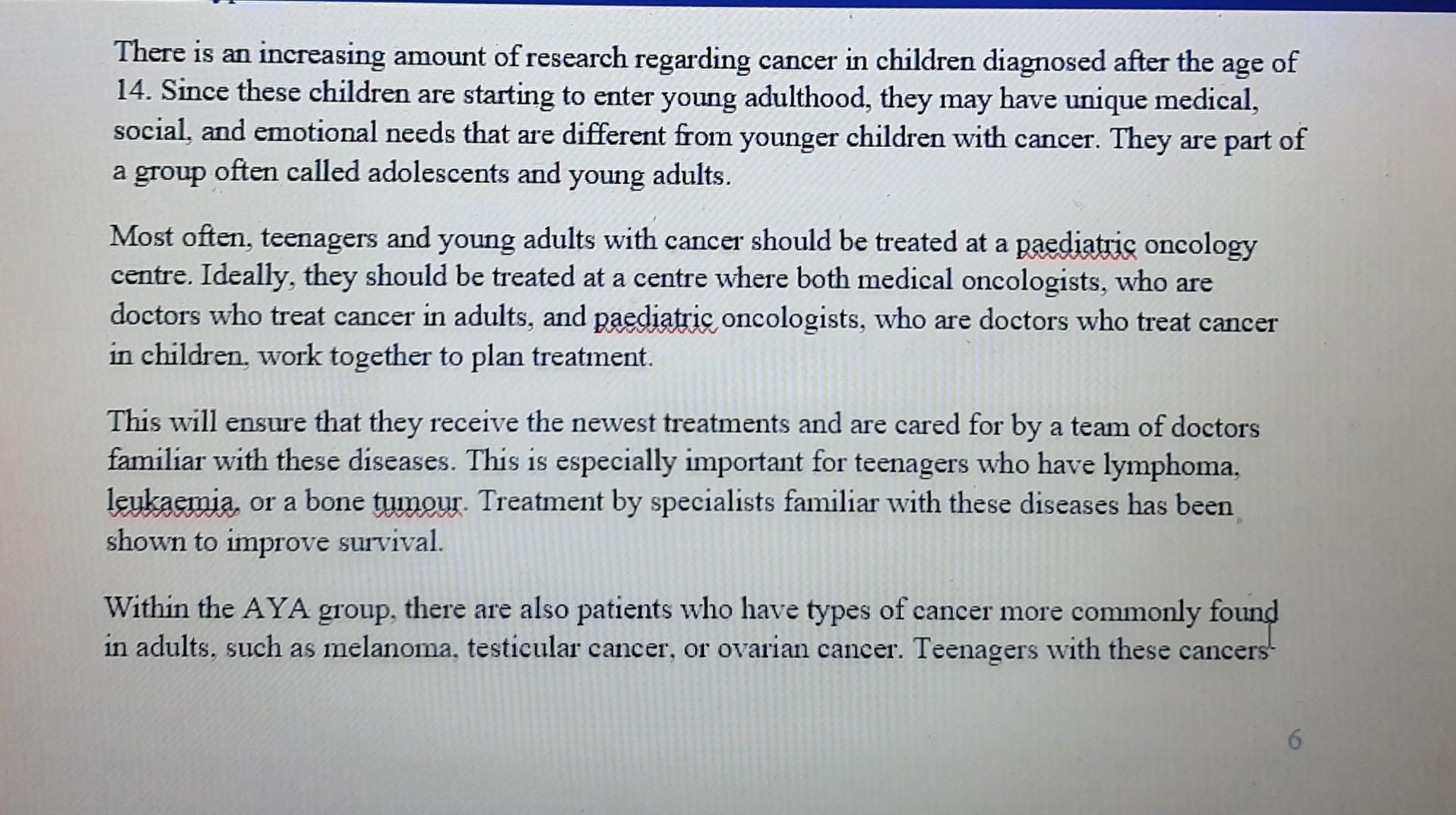
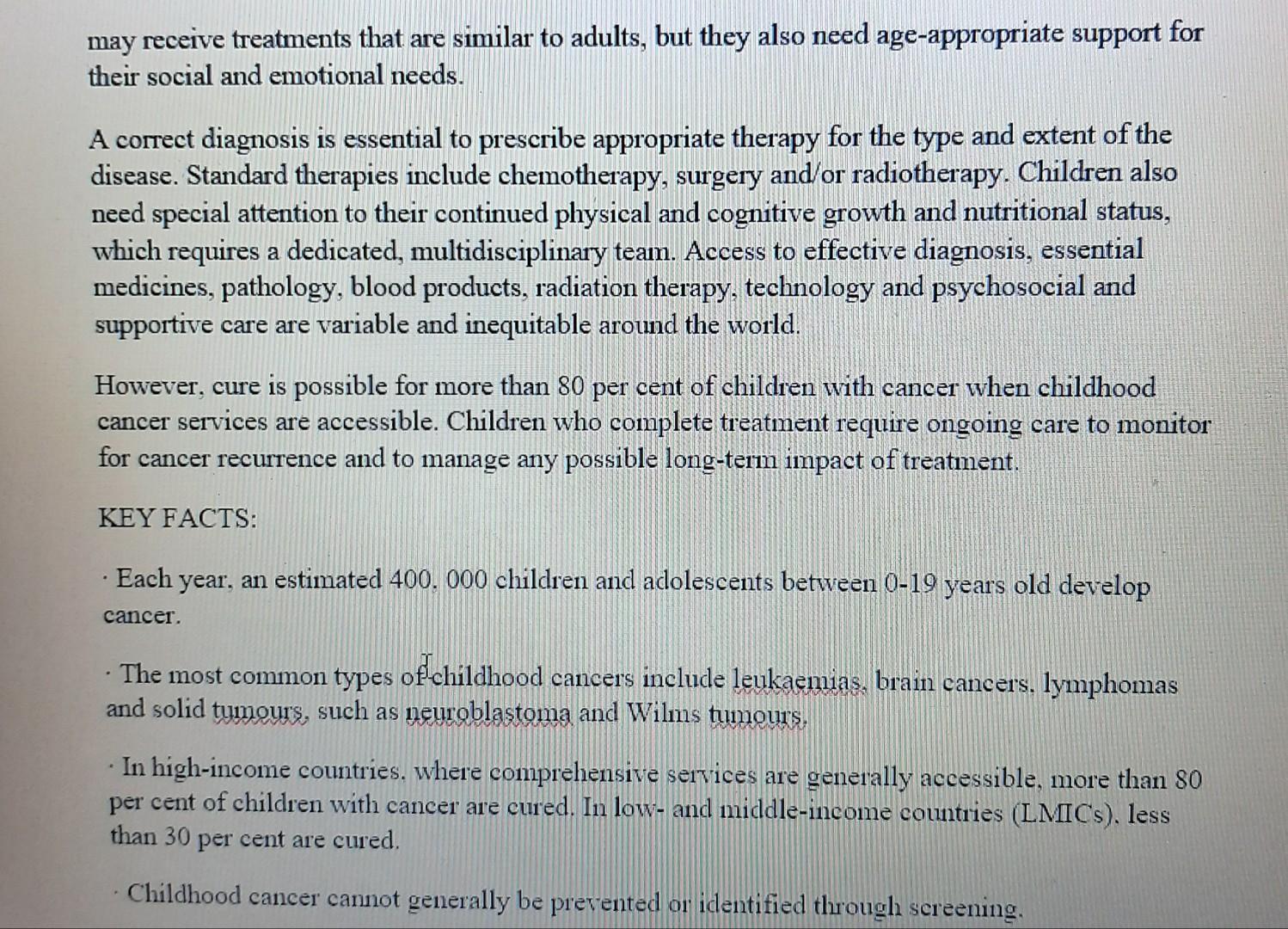
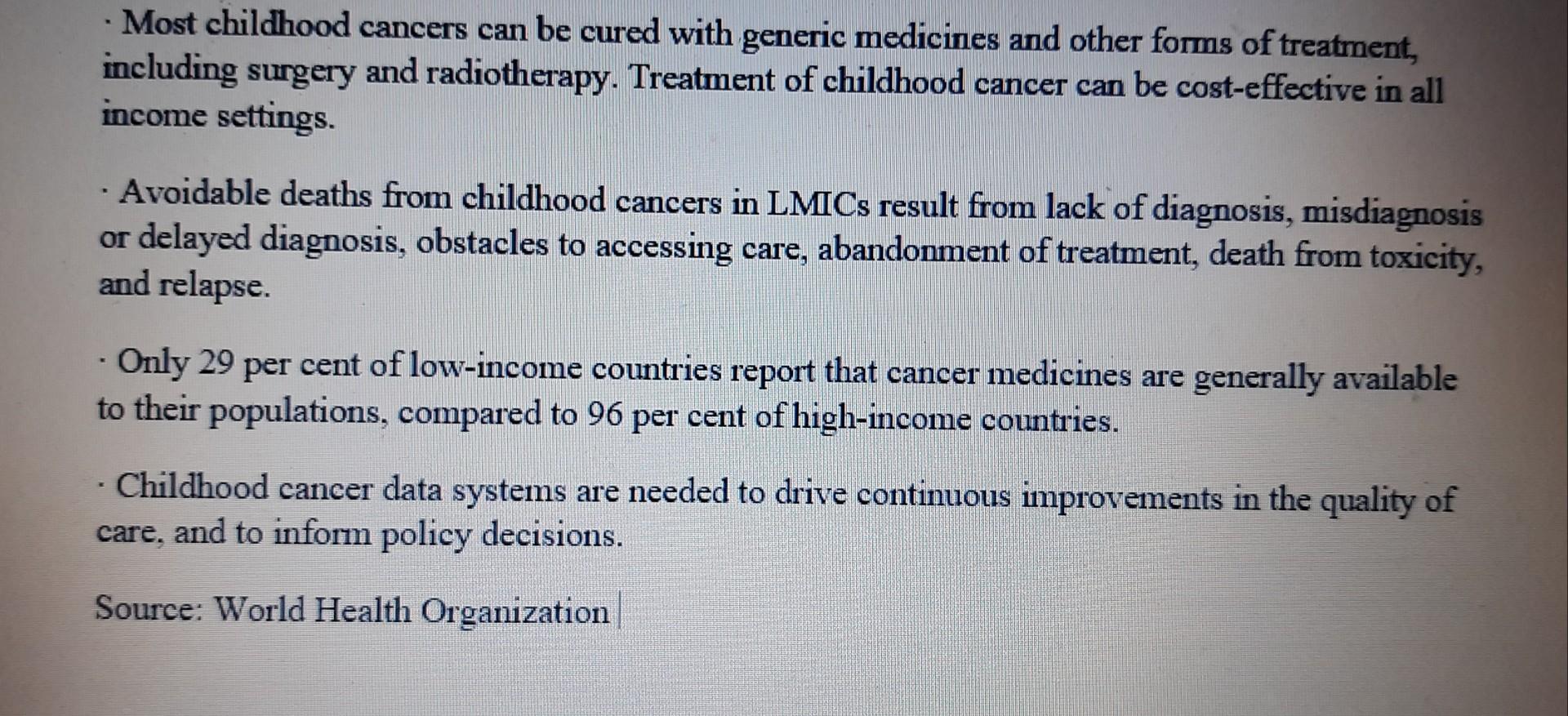
Instruction: Attached are five (5) articles/cases. In completion of this course work assignment, you are required to perform the following on each: 1. Provide a brief summary of the article/case, ensuring that the main issue is adequately noted. 2. Analyze the article/case based on your knowledge of Risk Management and Insurance, report on what peril(s), hazard(s), risks and other pertinent factors were identified. 3. Examine how each of the four Risk Management techniques could be employed in each scenario to reduce or eliminate the risk itself. 4. Conclude with your recommendation as to the best risk management technique(s) you would employ. 1) 4-y-o St Mary girl killed in saspected home arson attack Published-Tuesday | October 18,2022337 PM A four-year-old girl was burnt to death after a fire, suspected to be the work of arsonists, destroyed her home in Dean Pen district, Highgate, St Mary Tuesday morning. She has been identified as Sariah Kowen. The girl's mother, Rose Beecher, 38 , and other family members also received injuries and are said to be in serious condition in hospital. The incident happened around 4 o'clock 4-y-o St Mary girl killed in suspected home arson attack The St Mary home of four-year-old Sariah Kowen who died in a suspected arson attack on October 18,2022 . It is reported that the occupants of the house were asleep when Beecher felt a liquid substance on her and then immediately felt a fire. When she got up, the house was engulfed in flames. She managed to run to safety but received severe burns to her body. She was unable to alert or assist anyone. The fire department was called and after cooling down operations the charred remains of her daughter were found. The girl's father, Okoy Kowen, who lives elsewhere, told reporters that he has been left devastated by the death of his child. "Mi never know if she burn up or what but when mi come inna di taxi mi hear that mi daughter burn up in the fire; mi start cry. I heard she was sleeping and somebody came and throw a bottle bomb through the window, " Kowen said. "She was nice, good looking, and jovial," he said of his daughter. Acting Commandant for the St Mary police division, Deputy Superintendent Kevin Francis, told The Gleaner that investigations are ongoing. He said the police are treating the incident as a case of suspected arson. ABUJA, Nigeria (AP) - The death toll from floods in Nigeria this year has increased to 603 as local authorities race to get relief items to hundreds of thousands being evacuated from their submerged homes. More than 1.3 million people have been displaced by the disaster, which has affected people across 33 of Nigeria's 36 states, the nation's humanitarian affairs ministry said late Sunday. At least 340,000 hectares of land also have been affected, worsening fears of food supply disruptions. Armed conflict already has threatened production in the northwest and central regions of Nigeria, which produce much of what the country eats. Nigerian President Muhammadu Buhari directed "all concerned to work for the restoration of normalcy," according to a statement issued by the presidency. Nigeria experiences annual flooding especially in coastal areas but this year's floods are the worst in more than a decade. Authonities blame the disaster this year on the release of excess water from Lagdo dam in neighbouring Cameroon and on unusual rainfalls. The flooding has worsened the humanitarian crisis in Nigeria where armed violence especially in the troubled northern region has already displaced more than 3 million people, according to the Internal Displacement Monitoring Center. Sadiya Umar Farouq, Nigeria's minister of humanitarian affairs, warned that five states are still at risk of experiencing floods up till the end of November. "We are calling on the respective state governments, local government councils and communities to prepare for more flooding by evacuating people living on flood plains to high grounds," Farouq said. Last week, President Buhari approved 12,000 metric tons of grains for the flood victims, the humanitarian affairs minister said. Spotlight on Jam-Dex, real estate, lawyers, used-car and hardware trade. Some used-car dealers, hardware merchants, and real estate agents and developers are again being singled out as facilitators of breaches of the million-dollar limit for cash transactions in Jamaica, and possibly participating in, or at least leaving the door open to other financial crimes, including money laundering. The latest charge comes from Selvin Hay, chief technical director of the Financial Investigation Division, FID, as he spoke at the annual Anti-Money Laundering/Counter-Financing of Terrorism, or AML/CFT, conference, hosted by the Jamaica Bankers Association and the Jamaica Institute of Financial Services. Hay urged financial sector representatives to step up their reporting of suspicious transactions. "I know [that] law enforcement needs to]do more in terms of intelligence gathering - and I have been speaking about this, because a lot of intelligence is on the ground that we are not capturing - but we all have a role to play in this fight against money laundering," he told the conference, held October 11-12. Property developers are not included in Jamaica's AML/CFT legislative regime. Neither are lawyers, who are fighting their inclusion with a case now before the United Kingdom Privy Council, challenging amendments to the Proceeds of Crime Act 2007 and regulations. They are also objecting to changes to the Legal Professional Act and Canons, and the issuance by the General Legal Counsil of Jamaica, of anti-money laundering guidelines that compel attorneys to report money laundering and other possible financial crimes by their clients or face imprisonment. The absence of these to groups from the AML/CFT legal framework is said to be responsible, in large part, for Jamaica being included in the so-called blacklist of non-compliant jurisdictions and the greylist of jurisdictions under increased monitoning by the Financial Action Task Force that polices AML/CFT compliance globally. Jam-Dex warming This week, Hay said technology has enabled lawbreakers, such as scammers and hackers, to reduce their risk profile by limiting their apparatus to simply a mobile phone or laptop. He had a dire warning about the possible rise in cybercrimes in Jamaica with the advent of Jam-Dex, the central bank digital currency or CBDC issued by the Bank of Jamaica. "Jamaica has entered another threshold on the financial system. It has now become one of the countries with a higher risk by virtue of the fact that we have a digital currency. It's very good to have a digital currency that will enable people to transact business easily, but the vulnerabilities that are associated with it will allow us to be looked at in that (high-risk) category, "he said. The FID chief noted that fraud against financial institutions is on the increase, with credit card fraud being rampant as perpetrators become more efficient. This has forced financial companies to beef up security for online transactions. Scotiabank Jamaica, for example, has advised clients that as of Wednesday this week it ended the optional use of debit card numbers as part of the authentication process for accessing bank accounts online. All account holders now require a unique username and password. Hay pointed to some staff of outsourcing firms, banks and telecommunications companies, and some account holders, as being part of cyberfraud networks. He cited what he described as the delay, or lag time, in addressing legislative weaknesses and legal loopholes, noting that attorneys representing persons accused of financial crimes are increasingly focusing on what he called "peripheral weaknesses of the law", rather than challenging the evidence against their clients. Hay also identified the need for financial institutions to standardise their security and compliance practices, as well as to take a less adversarial approach to cooperating with institutions like the FID to stamp out financial crimes. He is of the view that laws designed to prevent and punish financial crimes should be made more robust and resilient, in order to reduce damage to financial institutions and Jamaica's international reputation. The FID chief said the US-instigated anti-scamming task force, known as the Jamaican Operation Linked to Telemarketing, or JOLT, is being revived. It is said to include the Major Organised Crime and Anti-Corruption Agency of the Jamaica Constabulary Force, Jamaica Customs, US Immigration and Customs Enforcement, the US Postal Service, BPOs, remittance companies and banks. Meanwhile, a BOJ representative used the occasion of the conference to defend Jam-Dex, reiterating the central bank's position that in the design and roll-out of the digital wallet, significant consideration was given to ensuring that it would not compromise the country's AML/CFT regime. BOJ Chief Prudential Officer Major Keron Burrell said the central bank also made its best efforts to ensure that the CBDC aligned with global best practices. He noted that even as the central bank was strengthening its own cyber framework with more in-house technology staff and consultants, it is urging the financial institutions it supervises to invest in advanced technology, including artificial intelligence and machine learning, to strengthen their digital platforms, data security and processes. Technology, he pointed out in his presentation on Wednesday, also improves customer experience and enhances required 'know your customer', or KYC, procedures, while increasing risk assessment and due diligence. Burrell gave the thumbs up to the impending National Identification System, NIDS, opining that it will improve authentication and reduce identity theft, while assisting KYC systems and helping to onboard new customers, leading to more legitimate business for financial institutions. He said that the BOJ is considering relaxing requirements for new account holders to provide financial institutions with references when NIDS comes on stream. This is expected to be done through revisions to the guidance notes issued to the institutions. The document, which is now being redrafted taking into account local and global changes, and evolving best practices, should be circulated to the financial sector by early next year as a consultation paper, Burrell said. 4) Letter of the Day | Broadcasting Commission's ban a massive step in the right direction THE EDITOR, Sir: Thank you, Broadcasting Commission, for your recent "delayed broadcast" of a directive to media houses, banning the broadceast of any music or utterance that promotes illegal activity. You have a free hand to do what is right for Jamaica without any fear of political repercussions because your members are not elected by the people. A refusal by (the) Government to take specific, common-sense steps to counter the scourge of crime and indiscipline is a direct challenge to, and contradiction of, its proposition that Jamaica is the 'place of choice to live, work, raise families and do business'. The twin-headed monster of crime and indiscipline can be defeated only by a multipronged, coordinated, and sustained attack at the social, economic, cultural, psychological and spiritual roots of the problem. The successful formula must include a menu of things that are to be done, as well as things that are not to be done by the Government and all stakeholders in our national initiative. It makes no sense to be pouring water and gasoline on the fire in a seeming attempt to extinguish it. I congratulate the Broadcasting Commission on a massive baby step in the right direction. I encourage the Government to throw the full weight of its political mandate behind the eradication of crime and indiscipline. Only then will many of our problems be solved, not overnight, but in a relatively short period of time. 5) Cancer curable for 80 per cent of children with early care CANCER IS uncommon in children. Most cancers develop in adults, and it is most common in older adults. About one out of every three adults will develop cancer during their lifetime, while about one in 285 children will develop cancer before the age of 20 . At the same time, there is a lot of research going on to discover new treatments for childhood cancers. This research has greatly improved the overall survival rate for children with cancer, which is now more than 80 per cent. Cancer in children can occur anywhere in the body, including the blood and lymph node systems, brain and spinal cord (central nervous system, or CNS), kidneys, and other organs and tissues. Most of the time, there is no known cause for childhood cancers. Childhood cancers may behave very differently from adult cancers, even when they start in the same part of the body. I Cancer begins when healthy cells change and grow out of control. In most types of cancer, these cells form a mass called a tumour. A tumour can be cancerous or benign. A cancerous tumour is malignant, meaning it can grow and spread to other parts of the body. A benign tumour means the tymour can grow but will not spread to distant parts of the body. In leukaemia, a cancer of the blood that starts in the bone marrow, these abnormal cells very rarely form a solid tumour. Instead, these cells crowd out other types of cells in the bone marrow. This prevents the production of normal red blood cells, cells that carry oxygen to tissues, white blood cells, cells that fight infection, and platelets - the part of the blood needed for clotting. Childhood cancer, also called paediatric cancer, is a general term used to describe a range of cancer types found in children. There is an increasing amount of research regarding cancer in children diagnosed after the age of 14. Since these children are starting to enter young adulthood, they may have unique medical, social, and emotional needs that are different from younger children with cancer. They are part of a group often called adolescents and young adults. Most often, teenagers and young adults with cancer should be treated at a paediatric oncology centre. Ideally, they should be treated at a centre where both medical oncologists, who are doctors who treat cancer in adults, and paediatric oncologists, who are doctors who treat cancer in children, work together to plan treatment. This will ensure that they receive the newest treatments and are cared for by a team of doctors familiar with these diseases. This is especially important for teenagers who have lymphoma, leykaemia or a bone tumour. Treatment by specialists familiar with these diseases has been shown to improve survival. Within the AYA group, there are also patients who have types of cancer more commonly found in adults, such as melanoma, testicular cancer, or ovarian cancer. Teenagers with these cancers- may receive treatments that are similar to adults, but they also need age-appropriate support for their social and emotional needs. A correct diagnosis is essential to prescribe appropriate therapy for the type and extent of the disease. Standard therapies include chemotherapy, surgery and/or radiotherapy. Children also need special attention to their continued physical and cognitive growth and nutritional status, which requires a dedicated, multidisciplinary team. Access to effective diagnosis, essential medicines, pathology, blood products, radiation therapy, technology and psychosocial and supportive care are variable and inequitable around the world. However, cure is possible for more than 80 per cent of children with cancer when childhood cancer services are accessible. Children who complete treatment require ongoing care to monitor for cancer recurrence and to manage any possible long-term impact of treatment. KEY FACTS: Each year, an estimated 400,000 children and adolescents between 0-19 years old develop cancer. - The most common types of childhood cancers include leukaemias, brain cancers. lymphomas and solid tumours, such as neuroblastoma and Wilms tumours. - In high-income countries, where comprehensive services are generally accessible, more than 80 per cent of children with cancer are cured. In low- and middle-income countries (LMICs). less than 30 per cent are cured. Childhood cancer cannot generally be prerented or identified through screening. Most childhood cancers can be cured with generic medicines and other forms of treatment, including surgery and radiotherapy. Treatment of childhood cancer can be cost-effective in all income settings. Avoidable deaths from childhood cancers in LMICs result from lack of diagnosis, misdiagnosis or delayed diagnosis, obstacles to accessing care, abandonment of treatment, death from toxicity, and relapse. - Only 29 per cent of low-income countries report that cancer medicines are generally available to their populations, compared to 96 per cent of high-income countries. Childhood cancer data systems are needed to drive continuous improvements in the quality of care, and to inform policy decisions. Source: World Health Organization Instruction: Attached are five (5) articles/cases. In completion of this course work assignment, you are required to perform the following on each: 1. Provide a brief summary of the article/case, ensuring that the main issue is adequately noted. 2. Analyze the article/case based on your knowledge of Risk Management and Insurance, report on what peril(s), hazard(s), risks and other pertinent factors were identified. 3. Examine how each of the four Risk Management techniques could be employed in each scenario to reduce or eliminate the risk itself. 4. Conclude with your recommendation as to the best risk management technique(s) you would employ. 1) 4-y-o St Mary girl killed in saspected home arson attack Published-Tuesday | October 18,2022337 PM A four-year-old girl was burnt to death after a fire, suspected to be the work of arsonists, destroyed her home in Dean Pen district, Highgate, St Mary Tuesday morning. She has been identified as Sariah Kowen. The girl's mother, Rose Beecher, 38 , and other family members also received injuries and are said to be in serious condition in hospital. The incident happened around 4 o'clock 4-y-o St Mary girl killed in suspected home arson attack The St Mary home of four-year-old Sariah Kowen who died in a suspected arson attack on October 18,2022 . It is reported that the occupants of the house were asleep when Beecher felt a liquid substance on her and then immediately felt a fire. When she got up, the house was engulfed in flames. She managed to run to safety but received severe burns to her body. She was unable to alert or assist anyone. The fire department was called and after cooling down operations the charred remains of her daughter were found. The girl's father, Okoy Kowen, who lives elsewhere, told reporters that he has been left devastated by the death of his child. "Mi never know if she burn up or what but when mi come inna di taxi mi hear that mi daughter burn up in the fire; mi start cry. I heard she was sleeping and somebody came and throw a bottle bomb through the window, " Kowen said. "She was nice, good looking, and jovial," he said of his daughter. Acting Commandant for the St Mary police division, Deputy Superintendent Kevin Francis, told The Gleaner that investigations are ongoing. He said the police are treating the incident as a case of suspected arson. ABUJA, Nigeria (AP) - The death toll from floods in Nigeria this year has increased to 603 as local authorities race to get relief items to hundreds of thousands being evacuated from their submerged homes. More than 1.3 million people have been displaced by the disaster, which has affected people across 33 of Nigeria's 36 states, the nation's humanitarian affairs ministry said late Sunday. At least 340,000 hectares of land also have been affected, worsening fears of food supply disruptions. Armed conflict already has threatened production in the northwest and central regions of Nigeria, which produce much of what the country eats. Nigerian President Muhammadu Buhari directed "all concerned to work for the restoration of normalcy," according to a statement issued by the presidency. Nigeria experiences annual flooding especially in coastal areas but this year's floods are the worst in more than a decade. Authonities blame the disaster this year on the release of excess water from Lagdo dam in neighbouring Cameroon and on unusual rainfalls. The flooding has worsened the humanitarian crisis in Nigeria where armed violence especially in the troubled northern region has already displaced more than 3 million people, according to the Internal Displacement Monitoring Center. Sadiya Umar Farouq, Nigeria's minister of humanitarian affairs, warned that five states are still at risk of experiencing floods up till the end of November. "We are calling on the respective state governments, local government councils and communities to prepare for more flooding by evacuating people living on flood plains to high grounds," Farouq said. Last week, President Buhari approved 12,000 metric tons of grains for the flood victims, the humanitarian affairs minister said. Spotlight on Jam-Dex, real estate, lawyers, used-car and hardware trade. Some used-car dealers, hardware merchants, and real estate agents and developers are again being singled out as facilitators of breaches of the million-dollar limit for cash transactions in Jamaica, and possibly participating in, or at least leaving the door open to other financial crimes, including money laundering. The latest charge comes from Selvin Hay, chief technical director of the Financial Investigation Division, FID, as he spoke at the annual Anti-Money Laundering/Counter-Financing of Terrorism, or AML/CFT, conference, hosted by the Jamaica Bankers Association and the Jamaica Institute of Financial Services. Hay urged financial sector representatives to step up their reporting of suspicious transactions. "I know [that] law enforcement needs to]do more in terms of intelligence gathering - and I have been speaking about this, because a lot of intelligence is on the ground that we are not capturing - but we all have a role to play in this fight against money laundering," he told the conference, held October 11-12. Property developers are not included in Jamaica's AML/CFT legislative regime. Neither are lawyers, who are fighting their inclusion with a case now before the United Kingdom Privy Council, challenging amendments to the Proceeds of Crime Act 2007 and regulations. They are also objecting to changes to the Legal Professional Act and Canons, and the issuance by the General Legal Counsil of Jamaica, of anti-money laundering guidelines that compel attorneys to report money laundering and other possible financial crimes by their clients or face imprisonment. The absence of these to groups from the AML/CFT legal framework is said to be responsible, in large part, for Jamaica being included in the so-called blacklist of non-compliant jurisdictions and the greylist of jurisdictions under increased monitoning by the Financial Action Task Force that polices AML/CFT compliance globally. Jam-Dex warming This week, Hay said technology has enabled lawbreakers, such as scammers and hackers, to reduce their risk profile by limiting their apparatus to simply a mobile phone or laptop. He had a dire warning about the possible rise in cybercrimes in Jamaica with the advent of Jam-Dex, the central bank digital currency or CBDC issued by the Bank of Jamaica. "Jamaica has entered another threshold on the financial system. It has now become one of the countries with a higher risk by virtue of the fact that we have a digital currency. It's very good to have a digital currency that will enable people to transact business easily, but the vulnerabilities that are associated with it will allow us to be looked at in that (high-risk) category, "he said. The FID chief noted that fraud against financial institutions is on the increase, with credit card fraud being rampant as perpetrators become more efficient. This has forced financial companies to beef up security for online transactions. Scotiabank Jamaica, for example, has advised clients that as of Wednesday this week it ended the optional use of debit card numbers as part of the authentication process for accessing bank accounts online. All account holders now require a unique username and password. Hay pointed to some staff of outsourcing firms, banks and telecommunications companies, and some account holders, as being part of cyberfraud networks. He cited what he described as the delay, or lag time, in addressing legislative weaknesses and legal loopholes, noting that attorneys representing persons accused of financial crimes are increasingly focusing on what he called "peripheral weaknesses of the law", rather than challenging the evidence against their clients. Hay also identified the need for financial institutions to standardise their security and compliance practices, as well as to take a less adversarial approach to cooperating with institutions like the FID to stamp out financial crimes. He is of the view that laws designed to prevent and punish financial crimes should be made more robust and resilient, in order to reduce damage to financial institutions and Jamaica's international reputation. The FID chief said the US-instigated anti-scamming task force, known as the Jamaican Operation Linked to Telemarketing, or JOLT, is being revived. It is said to include the Major Organised Crime and Anti-Corruption Agency of the Jamaica Constabulary Force, Jamaica Customs, US Immigration and Customs Enforcement, the US Postal Service, BPOs, remittance companies and banks. Meanwhile, a BOJ representative used the occasion of the conference to defend Jam-Dex, reiterating the central bank's position that in the design and roll-out of the digital wallet, significant consideration was given to ensuring that it would not compromise the country's AML/CFT regime. BOJ Chief Prudential Officer Major Keron Burrell said the central bank also made its best efforts to ensure that the CBDC aligned with global best practices. He noted that even as the central bank was strengthening its own cyber framework with more in-house technology staff and consultants, it is urging the financial institutions it supervises to invest in advanced technology, including artificial intelligence and machine learning, to strengthen their digital platforms, data security and processes. Technology, he pointed out in his presentation on Wednesday, also improves customer experience and enhances required 'know your customer', or KYC, procedures, while increasing risk assessment and due diligence. Burrell gave the thumbs up to the impending National Identification System, NIDS, opining that it will improve authentication and reduce identity theft, while assisting KYC systems and helping to onboard new customers, leading to more legitimate business for financial institutions. He said that the BOJ is considering relaxing requirements for new account holders to provide financial institutions with references when NIDS comes on stream. This is expected to be done through revisions to the guidance notes issued to the institutions. The document, which is now being redrafted taking into account local and global changes, and evolving best practices, should be circulated to the financial sector by early next year as a consultation paper, Burrell said. 4) Letter of the Day | Broadcasting Commission's ban a massive step in the right direction THE EDITOR, Sir: Thank you, Broadcasting Commission, for your recent "delayed broadcast" of a directive to media houses, banning the broadceast of any music or utterance that promotes illegal activity. You have a free hand to do what is right for Jamaica without any fear of political repercussions because your members are not elected by the people. A refusal by (the) Government to take specific, common-sense steps to counter the scourge of crime and indiscipline is a direct challenge to, and contradiction of, its proposition that Jamaica is the 'place of choice to live, work, raise families and do business'. The twin-headed monster of crime and indiscipline can be defeated only by a multipronged, coordinated, and sustained attack at the social, economic, cultural, psychological and spiritual roots of the problem. The successful formula must include a menu of things that are to be done, as well as things that are not to be done by the Government and all stakeholders in our national initiative. It makes no sense to be pouring water and gasoline on the fire in a seeming attempt to extinguish it. I congratulate the Broadcasting Commission on a massive baby step in the right direction. I encourage the Government to throw the full weight of its political mandate behind the eradication of crime and indiscipline. Only then will many of our problems be solved, not overnight, but in a relatively short period of time. 5) Cancer curable for 80 per cent of children with early care CANCER IS uncommon in children. Most cancers develop in adults, and it is most common in older adults. About one out of every three adults will develop cancer during their lifetime, while about one in 285 children will develop cancer before the age of 20 . At the same time, there is a lot of research going on to discover new treatments for childhood cancers. This research has greatly improved the overall survival rate for children with cancer, which is now more than 80 per cent. Cancer in children can occur anywhere in the body, including the blood and lymph node systems, brain and spinal cord (central nervous system, or CNS), kidneys, and other organs and tissues. Most of the time, there is no known cause for childhood cancers. Childhood cancers may behave very differently from adult cancers, even when they start in the same part of the body. I Cancer begins when healthy cells change and grow out of control. In most types of cancer, these cells form a mass called a tumour. A tumour can be cancerous or benign. A cancerous tumour is malignant, meaning it can grow and spread to other parts of the body. A benign tumour means the tymour can grow but will not spread to distant parts of the body. In leukaemia, a cancer of the blood that starts in the bone marrow, these abnormal cells very rarely form a solid tumour. Instead, these cells crowd out other types of cells in the bone marrow. This prevents the production of normal red blood cells, cells that carry oxygen to tissues, white blood cells, cells that fight infection, and platelets - the part of the blood needed for clotting. Childhood cancer, also called paediatric cancer, is a general term used to describe a range of cancer types found in children. There is an increasing amount of research regarding cancer in children diagnosed after the age of 14. Since these children are starting to enter young adulthood, they may have unique medical, social, and emotional needs that are different from younger children with cancer. They are part of a group often called adolescents and young adults. Most often, teenagers and young adults with cancer should be treated at a paediatric oncology centre. Ideally, they should be treated at a centre where both medical oncologists, who are doctors who treat cancer in adults, and paediatric oncologists, who are doctors who treat cancer in children, work together to plan treatment. This will ensure that they receive the newest treatments and are cared for by a team of doctors familiar with these diseases. This is especially important for teenagers who have lymphoma, leykaemia or a bone tumour. Treatment by specialists familiar with these diseases has been shown to improve survival. Within the AYA group, there are also patients who have types of cancer more commonly found in adults, such as melanoma, testicular cancer, or ovarian cancer. Teenagers with these cancers- may receive treatments that are similar to adults, but they also need age-appropriate support for their social and emotional needs. A correct diagnosis is essential to prescribe appropriate therapy for the type and extent of the disease. Standard therapies include chemotherapy, surgery and/or radiotherapy. Children also need special attention to their continued physical and cognitive growth and nutritional status, which requires a dedicated, multidisciplinary team. Access to effective diagnosis, essential medicines, pathology, blood products, radiation therapy, technology and psychosocial and supportive care are variable and inequitable around the world. However, cure is possible for more than 80 per cent of children with cancer when childhood cancer services are accessible. Children who complete treatment require ongoing care to monitor for cancer recurrence and to manage any possible long-term impact of treatment. KEY FACTS: Each year, an estimated 400,000 children and adolescents between 0-19 years old develop cancer. - The most common types of childhood cancers include leukaemias, brain cancers. lymphomas and solid tumours, such as neuroblastoma and Wilms tumours. - In high-income countries, where comprehensive services are generally accessible, more than 80 per cent of children with cancer are cured. In low- and middle-income countries (LMICs). less than 30 per cent are cured. Childhood cancer cannot generally be prerented or identified through screening. Most childhood cancers can be cured with generic medicines and other forms of treatment, including surgery and radiotherapy. Treatment of childhood cancer can be cost-effective in all income settings. Avoidable deaths from childhood cancers in LMICs result from lack of diagnosis, misdiagnosis or delayed diagnosis, obstacles to accessing care, abandonment of treatment, death from toxicity, and relapse. - Only 29 per cent of low-income countries report that cancer medicines are generally available to their populations, compared to 96 per cent of high-income countries. Childhood cancer data systems are needed to drive continuous improvements in the quality of care, and to inform policy decisions. Source: World Health Organization
Step by Step Solution
There are 3 Steps involved in it
Step: 1

Get Instant Access to Expert-Tailored Solutions
See step-by-step solutions with expert insights and AI powered tools for academic success
Step: 2

Step: 3

Ace Your Homework with AI
Get the answers you need in no time with our AI-driven, step-by-step assistance
Get Started


